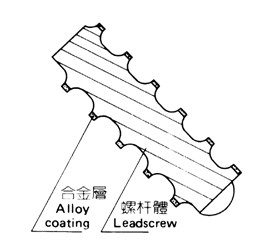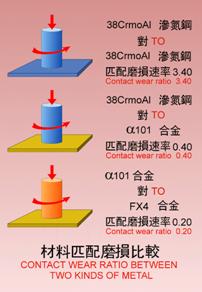Copyright © Shanghai Omega Machinery Co., Ltd. All rights reserved.
Alloy Layer Questions and Information for Bimetallic Screw
May 06,2016
Questions 1: Oxy-Acetylene Process for application of hardfacing powder:
Are you referring to the spray and fuse method for hardfacing the feed screws that were recently shipped to us? The hardfacing alloy is in powder form.
Usually the spray and fuse method for hardfacing the feed screws you mentioned is used for getting alloy layer all over the screw working surface, not like our normal case:only on the top of screw thread. That is through hardened screw like below:

Please pay attention that usually for this through hardened screw, there are two limits now, one is screw length, it has to be shorter than 1800mm; Another is thickness of alloy layer, it has to be thinner than 1.0mm.
Questions 2: Do you use the manual oxy-acetylene powder welding process? This is a one-step process compared to the two step spray and fuse method.
Yes, face to so many screw specifications, we have to use the manual oxy-acetylene powder welding process. Just like you say, in this technology way, spray and fuse, these two functions are finished in one step at the same time. And normally say the Spray and Fuse method way, above two functions are finished in two steps: First step is to spray on all over the welding surface, then second step is to fuse powder.
Question 3: Gas Tungsten Arc Welding (TIG):
Do you have experience hardfacing feedscrew flight tips using the Gas Tungsten Arc Welding Process? Filler metal is in bare rod form. Preheat shall be maintained during welding.
Yes, sometimes we use the way like you say: Gas Tungsten Arc Welding, it depends on which kind of alloy layer a costumer chooses. Such as Co-base material rod, like this time Stellite 1 on big screw, it really could be in Gas Tungsten Arc Welding way.
Normally say, for getting alloy layer on top of screw thread, there are three kids of way we could choose: One is OXY, another is Gas Tungsten Arc Welding, the third is electric welding. The adhesive strength of these three ways is different, the third is best and the OXY is worst. But for our experience, the cracks would appear onside all these three process.
More information is, for some kinds of alloy layer, such as Ni 60, NiWC25 and NiWC35, we usually use these kinds of alloy, but there is no rod form that Shanghai Stellite could provide, they only supply these alloy in powder form.
Question 4: Pre-machining of feedscrew:
Do you pre-machine the feedscrew flights prior to hardfacing? Or do you machine a groove preparation for the hardfacing alloy in the O.D. of the billet?
There are two ways in making process to get the alloy layer on top of screw thread: One is pre-machine the feedscrew flights priorto hardfacing, another is to machine a groove preparation for the hardfacing alloy in the O.D. of the billet. It is based on the form of alloy layer. If it is normal form(Like shows right), we usually use the former way. The advantage of the former way is that all sides of the alloy layer is hard, no any other remained base material.


Question 5: In the barrels that Shanghai Omega have been making for us, you have supplied an equivalent of X Aloy102. Please can you confirm the exact technical specification of the material and forward a data sheet (as you have done for the NiCW 25 and 35).
Are these two materials what you would recommend as a set, compatible for use with each other?
To choose the alloy material for a bimetallic barrel and a bimetallic screw, first regard is what about the contact wear ratio between these two kinds of metal. Usually say, the contact ratio is worst when the same metal in contact wear case, Like the picture shows right. Due to Omega 101(The same as X 102) is Iron-base metal, and the Ax4 alloy is Ni-base material, they has a best contact wear ratio. This is why we choose them as to be a working alloy layer in normal way.
Chief Engineer Office
Shanghai Omega Machinery Co., Ltd
- Information
- How should one select the molding equipment when generating PP water supply pipes?
- Why do the surfaces of extruded profiles have weld marks when extruding? What are the solutions to eliminate these marks?
- Why do large, dull and unreflective bubbles appear on the surface of the special profiles? How can this problem be solved?
- What causes the uneven surface and poor gloss of the sheet during the sheet extrusion process? How can it be solved?
- Why does the cooling process for profile extrusion become unbalanced?
- What countermeasures can be taken to improve the dimensional and positional accuracy of profiles during the profile production process?
- How should profile molds be cleaned and maintained?
- What are the corresponding solutions to the phenomenon of grooves and pits on the surface of profiles?
- How should the raw materials be selected in the formula for PVC surface skin core layer microcellular foamed extruded profiles?
- How should the production process of biaxially oriented polyethylene terephthalate (BOPET) film be controlled?
- Contact Us

-
Shanghai Omega Machinery Co., Ltd.
Add.: No.168 Hualian Road, Putuo District, Shanghai City
Contact: Nina
Tel.: +86-021-69921527
Mobile: +86-15021464410
Fax: +86-021-69921567
E-mail: omegajessica@163.com;965425705@qq.com
WeChat No.: 1131449532
Whatsapp: +86 159 0054 6558

-